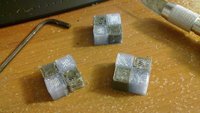 Most 3D printing companies and services experiment by introducing new products from time to time, and MakerBot is definitely one of the most experimental of companies. This time they’ve introduced something quite radical that may revolutionize personal 3D printing in the future: Dissolvable print material.
Most 3D printing companies and services experiment by introducing new products from time to time, and MakerBot is definitely one of the most experimental of companies. This time they’ve introduced something quite radical that may revolutionize personal 3D printing in the future: Dissolvable print material.How does it work? Their new polyvinyl alcohol plastic filament has an unusual property: it dissolves when immersed in cold water. If you set up your printer’s configuration properly (because PVA has a different melting point from both ABS and PLA plastics), you can print 3D shapes that will disappear when wet.
Now you may be wondering why disappearing objects is such a big deal. It’s not that we want objects to disappear – it’s that we want support material to disappear. Most personal 3D printers are extrusion based, meaning they build layer upon layer by extruding on top of lower layers. But this technique only allows certain shapes to be built, because some pathological shapes cannot be positioned such that all layers rest on lower layers. Consider a figurine with arms outstretched – what holds up the arms as they are printed?
The answer is support material. Print temporary stuff underneath the arms (in the figurine case) and then cut it away later. This approach works, but results in rough models because of carving marks where the support material has been removed, and sometimes difficult models require substantial amounts of support material that can be tedious or even impossible to remove.
The answer, as is already used by large-scale industrial 3D printers, is to print supports with a different material – one that can be easily removed by dissolving it away. In some cases this is a questionable chemical bath, but MakerBot’s PVA requires only tap water.
The other requirement will be a second print head to enable printing of support and “active” material during a single print operation. This is why PVA is a future benefit, as MakerBot does not yet offer a second print head option. However, on the Thingiverse blog Allan Ecker believes that even if a second head were available, we would still prefer to print without supports because the cost of PVA is significant – much higher than the actual print material you want to keep (USD$70/kg vs. USD$22/kg for ABS). Nevertheless, this material cost is spectacularly lower than custom cartridges for industrial 3D printers that can range up to USD$500 per kg!
We can’t stop suspecting a second printhead option is in the works. We’re checking the MakerBot blog every few minutes for an announcement, especially so soon after they released their newest extruder: The Stepstruder. What could their extruder team be working on next? Hm.
Nevertheless, MakerBot defines the best possible use for this new tech: Robots That Melt.
Via MakerBot and Thingiverse


nice but I still think that support material should be something extremely cheap like flour paste for example. I saw that an experimental paste extruder was already uploaded on thingiverse.